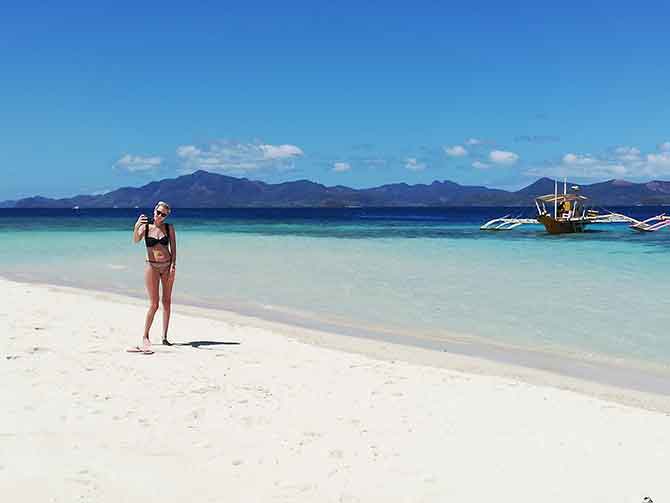
“Have you been enjoying Coron so far?” I asked a German national in the same island-hopping tour I was in.
He is 71 years old, like me, and traveling with his wife and sister-in-law. Though he’s been to the Philippines several times, it was also his first time in Coron.
In typical German frankness, he said wryly, “so far, I have not seen anything that impressed me.”
“Amen to that,” I said to myself.
Our negative impression of Coron may be taken as an act of sacrilege by those who have been there and enjoyed it.
If you haven’t and are contemplating going there, this article is a primer so you will know what to expect when you get there.
So read on.
Welcome to Coron
Do you know that there are two Corons? Yes, Coron Town and Coron Island.
To get to both, you have to fly into Busuanga Island – one of the three largest islands in the Calamian Group of islands (the others are Culion and Coron).
Busuanga Airport is small but clean and orderly. It is dainty. And for an airport its size, it is busy. Several flights fly in and out on a daily basis. All of them are either from or bound for Cebu, Manila or Pampanga – all local destinations.
Outside is hot and sparse, with hardly any shade. But you won’t miss the endless line of tourist vans discharging or picking up tourists. If your reservation is in order, a driver will be there to greet you.
From the airport, it is a short 30 min drive along a well-concreted hi-way, devoid of traffic, to Coron town 22 kms away.
Town of Coron

Town church – the epicenter of any Philippine town
Coron is a first-class, seaside municipality on the northwestern tip of Palawan. It is built on a hillside and all roads, except those following its contour, go up or go down – depending on your destination.
Most roads are concreted but are small and narrow. Some even look nothing more than alleys. And they are often clogged with traffic – from private cars, delivery and tourist vans and the ubiquitous tricycles, the only mode of public transportation in town.
There is no evidence of any urban planning or a traffic management blueprint. And all its facilities and utilities, i.e., hotels, restaurants, convenience stores, etc., are like Lego blocks dumped haphazardly on a hillside. They are everywhere and nowhere.
So make sure your hotel is a walking distance away from a decent restaurant. Otherwise, dining will be a problem since most hotels only serve breakfast.
Coron Island
Across a narrow strait and 17 kms away is Coron Island.
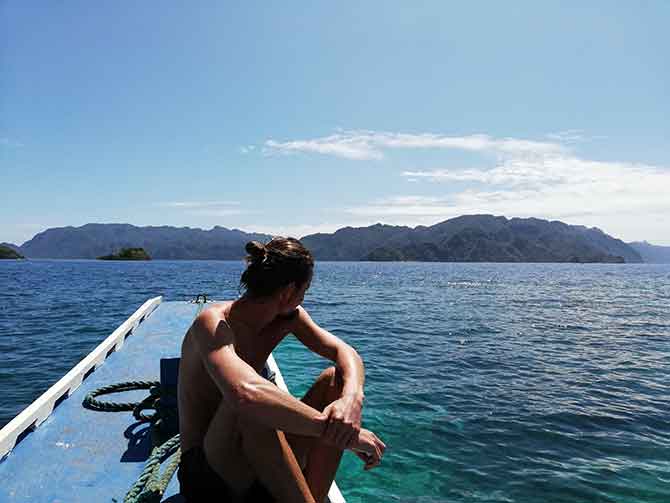
Coron island from a distance
It is a forbidding limestone mass of 71 sq km of mountains and craggy hills that was pushed skyward from the bowels of the earth millions of years ago – as shown by the series of perpendicular and parallel shear lines – bottom to top – along its entire inhospitable surface.
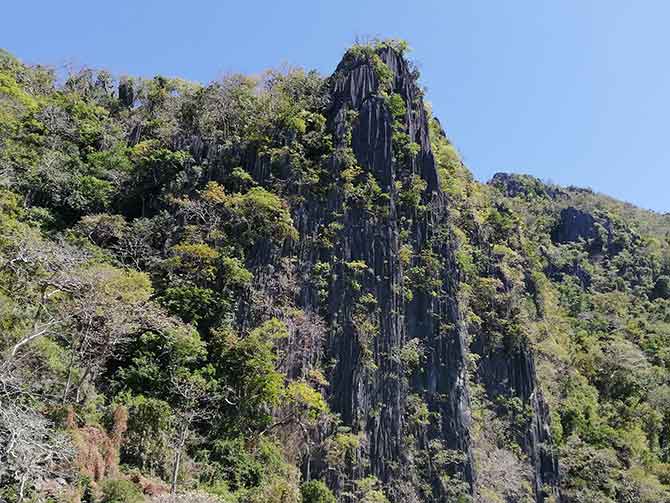
Up close
Nothing thrives in Coron Island but the hardiest of vegetation and the Tagbanwas.
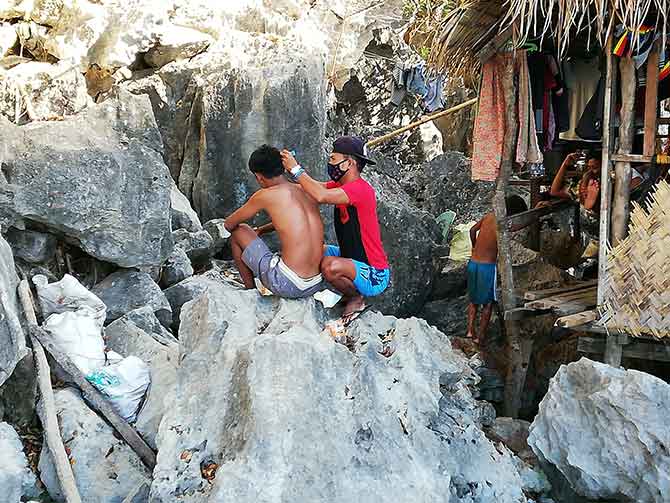
Tagbanwa young men – haircut on the rocks
The Tagbanwas is one of the oldest ethnic groups in the Philippines found in central and northern Palawan and is thought to be the earliest settlers of the island. By official edict, they, and only they, are settled on the island.
They oversee the tourist spots in the entire Calamian Islands. On the side, they gather birds’ nests like that in El Nido.
State of tourism in Coron
There are more tourists than residents in Coron. In fact, in 2018, when there were 51,000 natives of Coron, the ratio between residents to tourists was 1/4. And there are no signs of abating since then.
Coron thrives on tourism, nothing else. The fishermen of yore no longer catch fish but tourists who hunger for island-hopping tours.
And the group that is orchestrating, and raking in windfall profits in the process, are the tourist agencies. There are almost a dozen of them and they share one thing in common – maximize profits to the detriment of the paying tourists.
Consider these:
- More often than not, tours have no tourist guides. If there is, he or she falls short of what a guide is supposed to do. He/she is more of a passenger than a source of useful and important information about a destination.
- Food served during island-hopping tours is horrible even for the palate of local tourists.
- Boat dispatching – where tourists are assigned boats – is crude and primitive. The dispatcher, with a list of tourists for the day, sits on a small stool under the shade of a banyan tree while tourists, under the heat of the sun, jostle to check what boat they are assigned to.
To aggravate things, Coron travel people don’t take to criticisms lightly. They are defensive, always hiding behind the argument that “they are just starting in the business.”
Maybe that’s true. But there is no shortage of noteworthy tourist destinations in the Philippines to learn from. For example, Puerto Princesa is just a few kilometers to the south.
What to expect in Coron
Don’t expect anything breath-taking or something spectacular or awesome in Coron.
There is none. It is over-rated; pure hype. It’s a product of word-of-mouth and social media advertising embellished by heavily-edited images.
But expect to have the town tour and island-hopping tours.
Town tour:
This is a short road trip that makes stops on interesting points in town. Foremost among theme are:
- Mt. Tapyas: It’s drawing power is the observation deck 210 meters up. The top offers an unobstructed panoramic view of the entire environs of Coron and Coron Island – a few kilometers to the south.
Getting up there is a challenge for people with weak knees (like me) because it requires scaling a series of 900 or so steps uphill. So I passed.
- Maquinit Spring is one of the very few hot saltwater springs in the world. With traces of sulfur and temperatures ranging from 30 to 40 degrees C, it is a perfect place to relax after coming down from Mt. Tapyas.
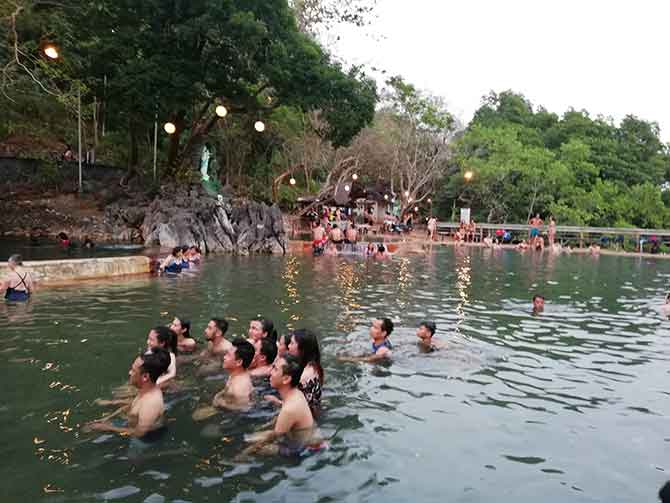
Exercise caution, though. By any measure, it is a public pool. And just like any public pool, hidden health risks abound. It may be therapeutic – if you are alone. But if you are with a platoon of people, think twice before taking a dip.
Island-hopping tours:
There are almost 50 islands that make up the Calamian Group. Therefore, there is no shortage of islands to hop around.
For example, there are the islands of Bulog Dos, Malcapuya, Banana Island, Banul Beach, etc. They come and go like a blur; their names are soon forgotten after the boat lifts anchor to go to the next.
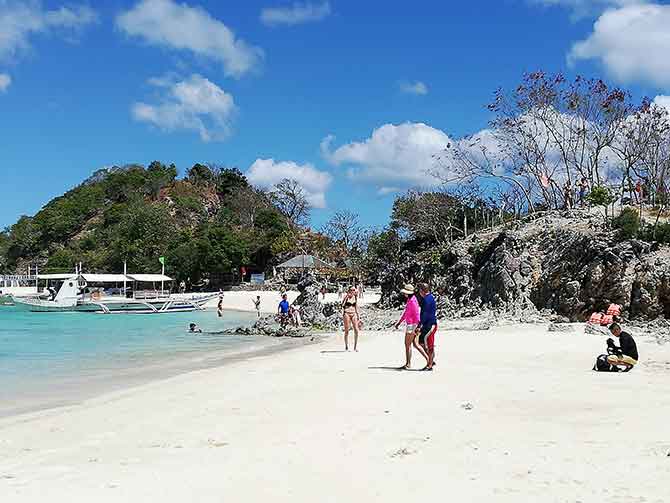
But they offer the same thing – a thin stretch of whitish/light brown sand surrounded by clear and clean waters. There is nothing much of value other than a short dip or taking selfies or group pictures. After a while, it becomes a drudgery.
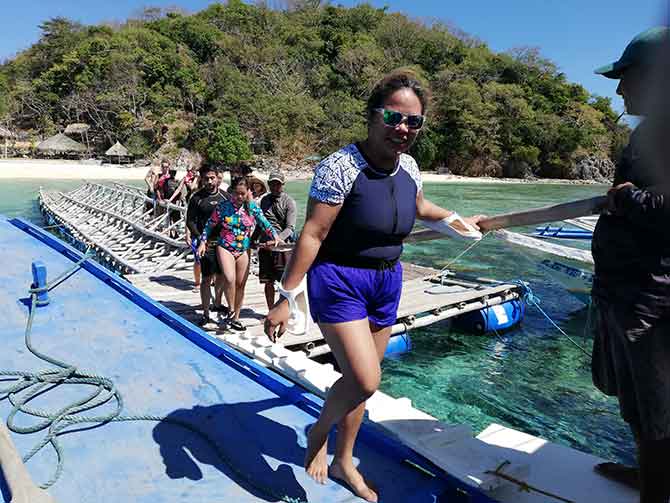
Francis Bacon once said,
“Nothing is pleasant that is not spiced with variety.“
Perhaps recognizing this fact, tour groups put in some non-beach destinations in their package. But, except for one, Kayangan Lake, they all are frustrating than pleasing.
So don’t expect to see any “Wow” factor in these:
Coral Garden is, of course, submerged and can only be appreciated by using a snorkel. The catch is you have to be a pretty good swimmer because the boat drops anchor a few meters away.
Skeleton Ship is on old Japanese naval vessel that was sunk by the Americans during the last war. But it may as well be called Phantom Ship because you cannot see it unless you scuba or free-dive 6 meters down.
Twin Lagoons is a pair of lagoons – the small and the big – adjacent to each other. The small lagoon is not really a lagoon as lagoons are defined and it can only be reached by wading through chest-deep water (short people not included).
The big lagoon in a real bummer because it is off-limits to tourists for safety reasons.
Yikes!!
Kayangan Lake
Kayangan Lake is a good place to de-stress after the big let-down from the previous three. Not for the lake itself but the sense of adventure the destination provides.
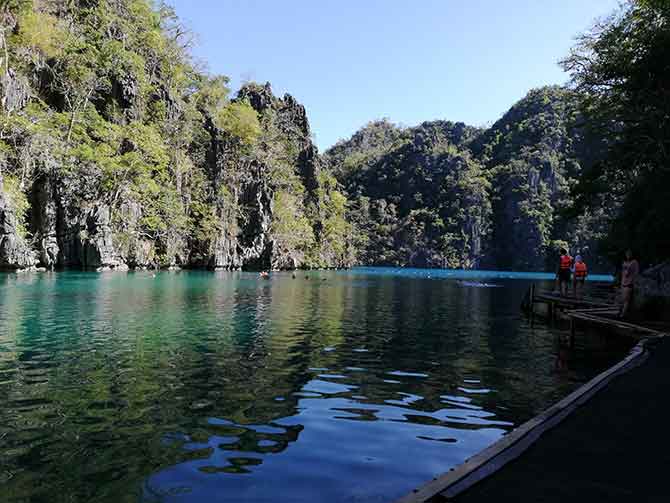
It is one in seven lakes in Coron Island. Getting there is a challenge – scaling more than a hundred steps up and two hundred or so down along a narrow mountain trail.
At the crest is a ledge to take pictures of the amazing bay beneath your feet.
Though dubbed as one of the cleanest lakes in Asia, it lacks the charm and the bewildering beauty of either Sugba Lagoon, or Bucas Grande in Siargao.
Coron could easily spruce it up by putting in things to engage tourists who labored long and hard to get there. A diving platform in the middle, or kayaks or foot-pedaled boats could go a long way to make a tourist’s visit memorable.
Or put up a small shop selling Tagbanwa artifacts or souvenir items.
There are currently a few tourist destination sites in the Philippines that are equal to or better than Coron. And there is no doubt that many more will come into the picture in the near future.
When that happens Coron’s fishermen may go back to fishing for a drought of tourists to take island-hopping tours. I’ve traveled to quite a few places in the country. While some are worth re-visiting, Coron is not one of them.
~oOo~
s.